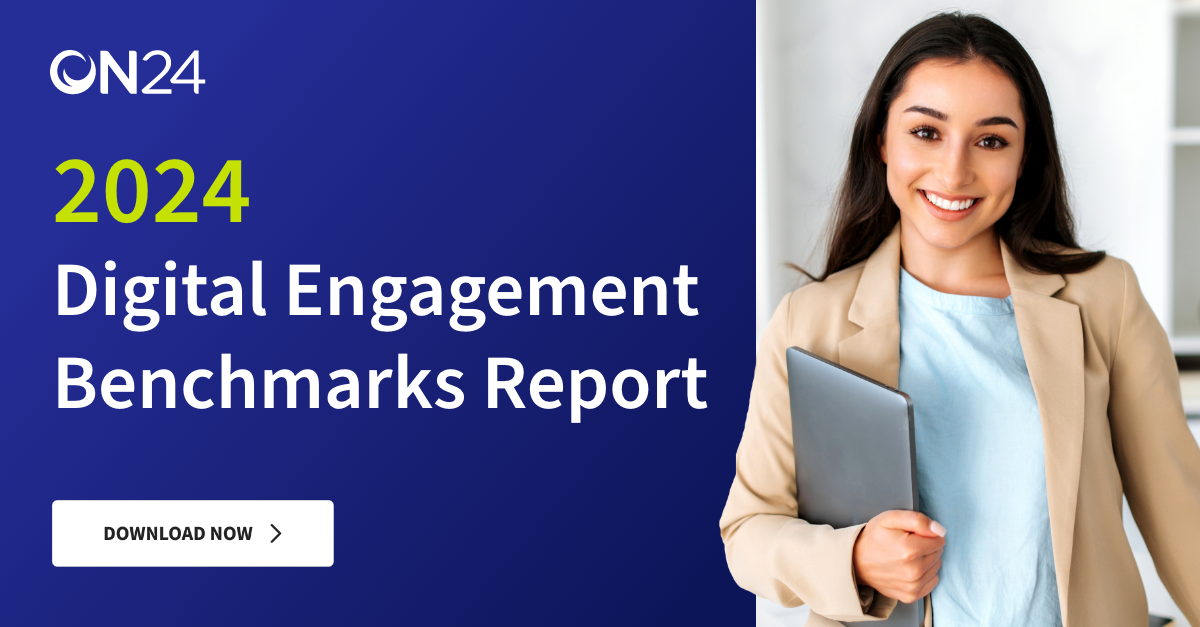When it comes to webinars and virtual events, marketers are constantly challenging themselves to optimize how they engage audiences and drive growth. And that’s an important challenge to meet — especially as they’re being asked to deliver more results with fewer resources. Using a data-driven virtual event platform such as ON24, can help streamline this process by offering the tools marketers need to engage audiences and measure success.
But what are the indicators of a successful virtual experience? What metrics should you track so you can optimize your programs for both scale and conversion?
Happily, we have some answers for you. Check out our five webinar success metrics below to help you understand your digital event performance and how you can use them to grow your programs.
1 Registrant to attendee conversion

A successful webinar will have a healthy registration-to-attendee conversion rate (the number of registrants divided by the number of attendees) — usually around 33% for a live event, according to our benchmarks report.
But beware: you should judge your conversion rate success based on the purpose of your event.
For example, small-scale events, like a forum or workshop, may need to have a higher conversion rate to be considered a success. Similarly, if you’re producing an on-demand series, like a virtual training course, then you’ll want to monitor your conversion rate over time since many of your conversions will be from on-demand traffic.
Mastering your registrant-to-attendee conversion rate is important. Knowing how many attendees you’re likely to get from an event (and thus qualified leads) is essential to building out a predictable pipeline for your sales team. It can also help you allocate resources and staffing to help boost engagement during your event.
2 Attendee engagement rate

Engagement is one of the most critical metrics for evaluating the success of any digital event. A high engagement rate means your audience is excited about your content, trusts your opinion and is interested in what your brand has to offer.
An engagement rate is also an important metric to understand how much your messaging resonates with audiences and signals how reliably you can turn engaged attendees into qualified leads.
While a high engagement rate is always desirable, remember that not all engagement is created equal. Polls and surveys are great engagement tools, but they provide you with different insights when compared to, say, a Q&A chat or a video-to-video conversation. That’s why it’s important to have a good mixture of engagement tools and an overall engagement strategy to guide your webinar program.
The importance of engagement in webinars and digital events cannot be overstated. Engagement data can provide you with both a high-level macro view of your audience and segments and with first-party data insights into a specific account. Enabling both your sales and marketing teams to personalize outreach, cater interactions to an account and much more.
3 Attendee to sales qualified lead conversion rate

So we’ve gone through registrant to attendee conversion rate and engagement metrics and why those two are important. Now, let’s build on those two metrics with the attendee-to-SQL rate.
This metric is relatively simple — all it does is measure how many attendees engaged with your content — but it’s critical for understanding how the first two metrics interact and how effective your webinars and digital experiences are at accelerating the buyer’s journey.
However, this metric will require a bit of work on your end. You’ll need to sit down with your sales team and negotiate and define holistic criteria for MQLs and SQLs for all marketing activity. Often, this will involve a mix of firmographics, an account’s industry and relationship with your brand and engagement data.
But once you’re done, you’ll be better positioned to predict pipeline and measure the efficiency of your top- and bottom-of-funnel programs, such as webinar demos, content hubs and more.
4 Engagement drop-off rate

And then there’s the engagement drop-off rate to consider. This is an important metric that helps you understand how long and how engaged your audiences are—and where and when they specifically stop engaging.
The engagement drop-off rate is a useful metric that can illustrate a mismatch between the topic of your event and audience expectations. It can also provide you insights on where within your events you need to make a push to keep audiences engaged and how long your events should be overall.
5 Click-through rate

Finally, there’s your CTA click-through rate. This simple metric estimates how often attendees will click on a high-intent offer.
A CTR is an important metric because it helps you better understand your customers. It’ll tell you which offers work, what topics resonate with audiences and can even help you forecast pipeline.
This rate is also a great way to measure your budget and its effectiveness at converting audiences and highlighting any cost-effective tactics for your program, like a particularly effective paid ad campaign or topic.
Calculating a CTR is simple: just divide the number of clicks on an offer or conversion point — like a book-a-meeting tool or resource link — by the number of views that offer had. For webinars, that means dividing how many attendees clicked on a CTA prompt against your webinar’s overall number of attendees.


